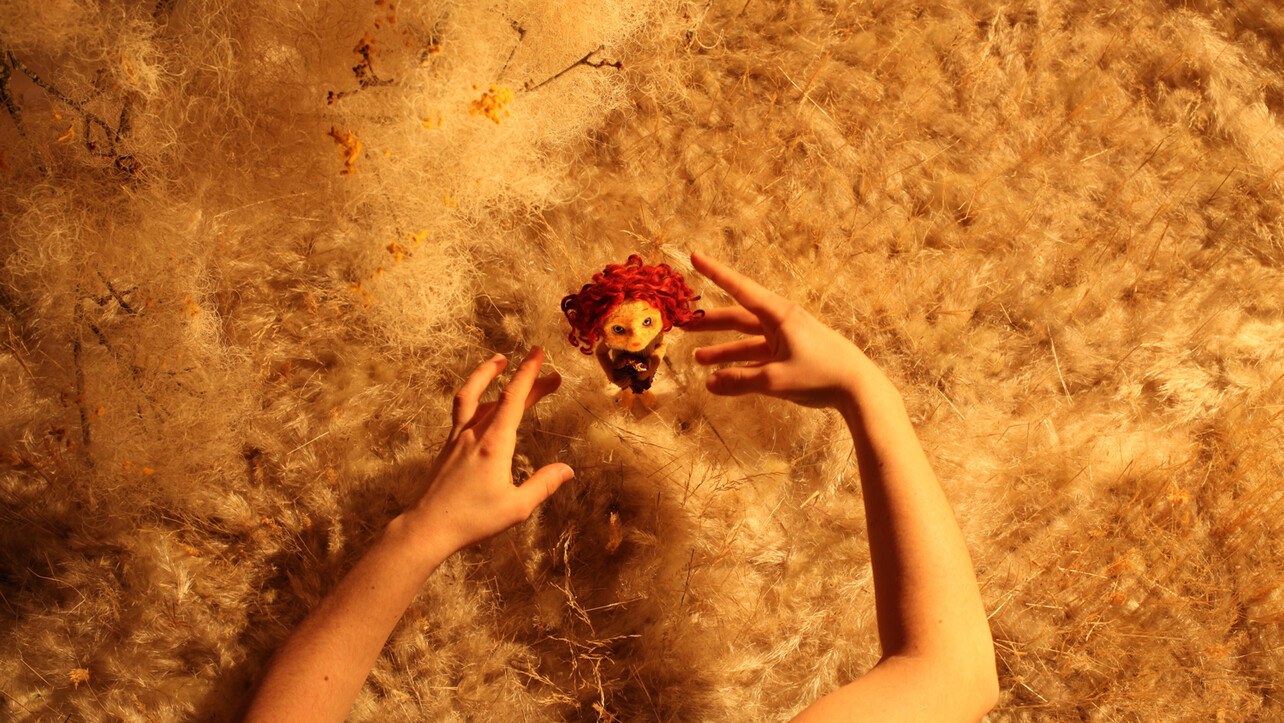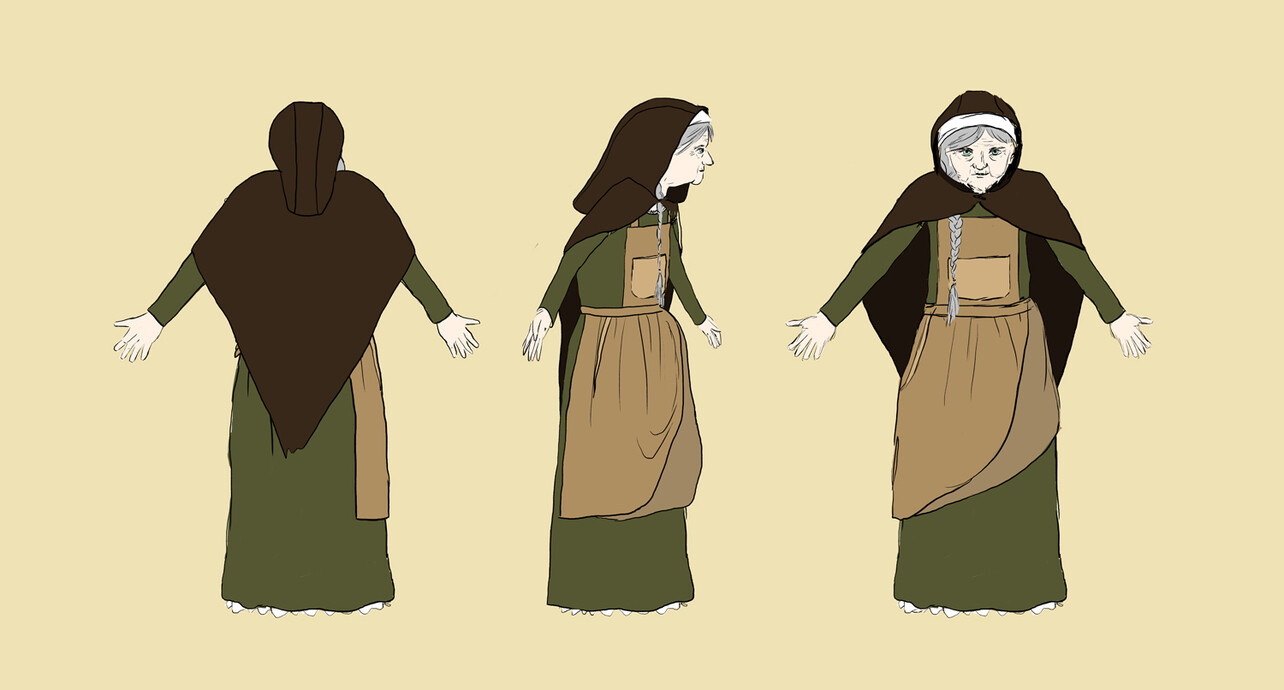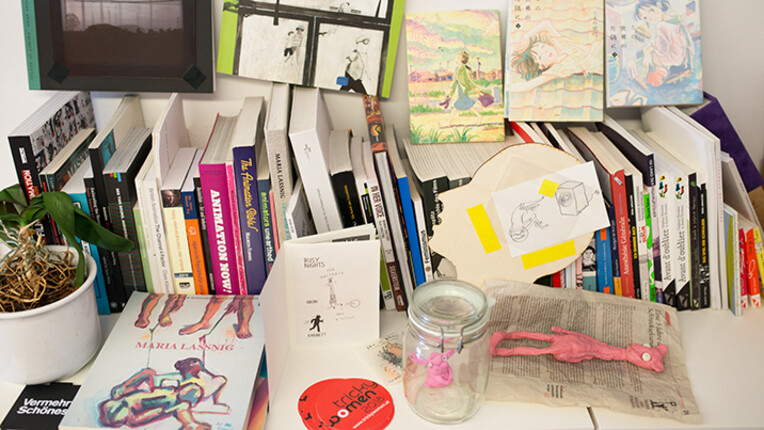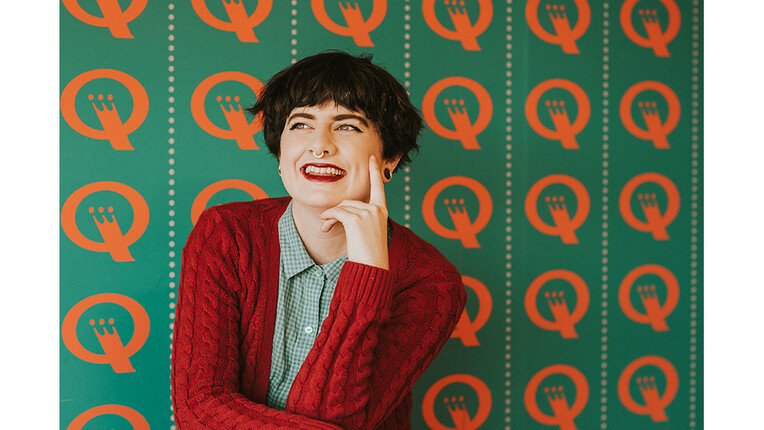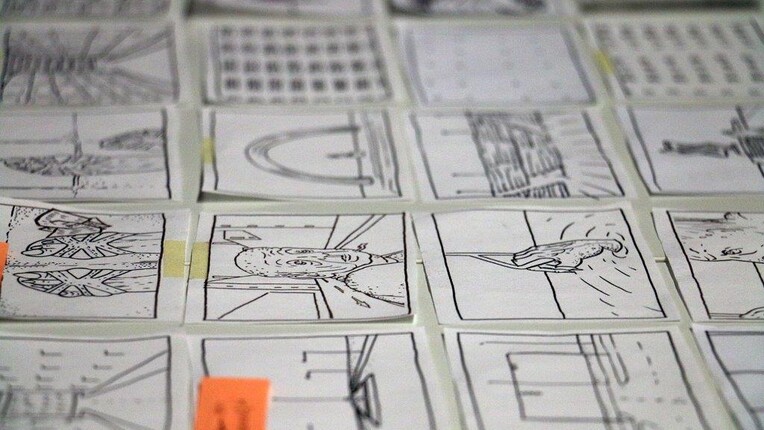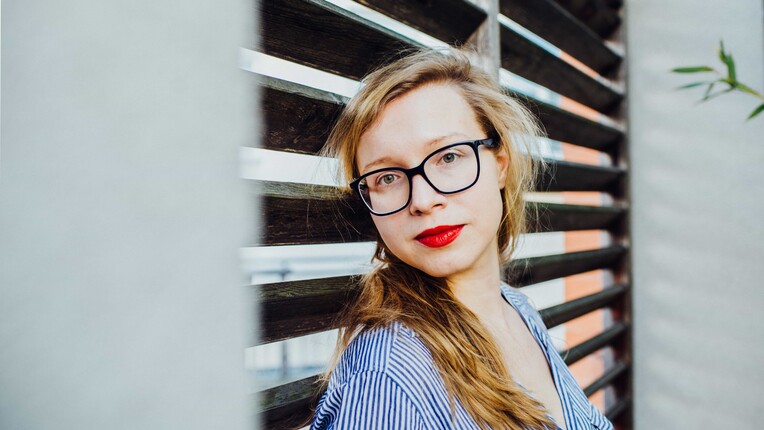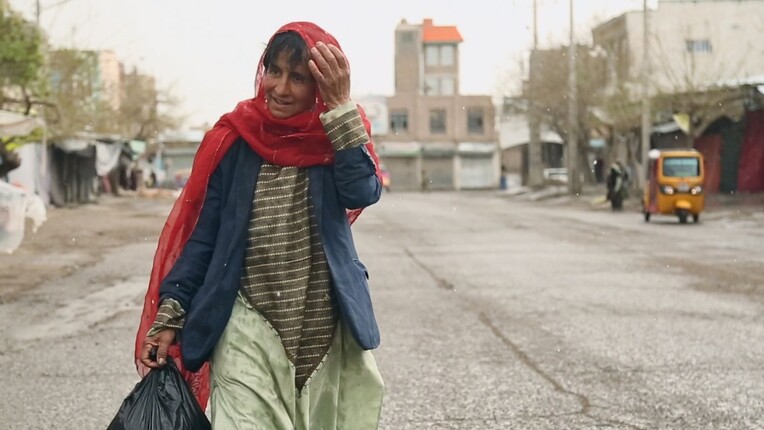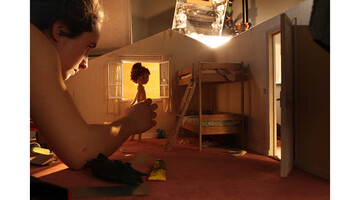
TRICKY WOMEN/TRICKY REALITIES 2022: Héloïse Ferlay
Waltraud Grausgruber, festival directress of the international animation film festival TRICKY WOMEN / TRICKY REALITIES, talks with Q21 Artist-in-Residence Héloïse Ferlay about her works and her residency in Vienna.
Héloïse Ferlay grew up near the turquoise lakes of Savoie and has now graduated of the Parisian school EnsAD. The making of Geôlier was her first hair-raising adventure in stopmotion animation, and Yola, in animated paint, just as much messed it up. Since, she cut her long hair off and To the dusty sea, her graduation film directed in great company in sweat, laughs and tears, went all around the world collecting more than 30 festival prices. Her latest little one, The girls of the wind, was just born, with even more wild-haired girls and emancipating children. She’s now working on a new short film project -and growing her hair again.
At last year's TRICKY WOMEN / TRICKY REALITIES festival, she won the 3-month scholarship and spends January, February and March 2022 as Q21 Artist-in-Residence in the MuseumsQuartier Wien.
Waltraud Grausgruber: You won the residency with your acclaimed stop-motion film To the Dusty Sea [À la mer poussière] - a portrait of a fragile family. What was important to you in terms of character design? For example: How did you create these amazing eyes, especially those of the mother which look like a blue ocean of tears.
Héloïse Ferlay: It’s interesting you talk about the eyes, because what was most important for me when I drew and first made the character designs was that the emotions would show through the characters as well as possible. I had to focus on the eyes, because with humans and real actors, they’re a window, to the soul, to the emotions. But with stop-motion puppets, there’s always some kind of distance because you know you’re not looking into real eyes. I decided to make them as realistic as possible and to make them stand out from the overall look of the rest of the film. This is why there’s such few shining things and objects, so that the big shining eyes take all the attention. Then I told myself some little stories to make choices regarding clothing, colours, height… Zoé is almost as tall as her mother because she’s taking her place when she’s gone. I gave her a tan because I imagined her wandering around in the sun, a little adventurous and daring girl, and brown eyes so she’s different from Malo and her mother. You can imagine she got her father’s eye colour. Madeleine, the mother, is all faded out, super white and liquid eyes, as she would like to disappear. Every choice you make in stop-motion has to have a little background story, it has to make sense, even if it’s just for you. Then you get a coherent universe.
Your new film The Girls of the Wind also uses stop motion and wool. What is it that fascinates you about this material?
I really love wool. I like hair and fur and fabrics, and wool has so many advantages. It catches the light beautifully, and it is a very resilient material to work with. It accepts a lot of your own errors, and you can always add a little bit of wool here and there, it is much easier to use than latex or silicon. It gives the film a very special touch or style, and more and more stop-motion directors and directresses are choosing it.
The Girls of the Wind is based on a poem by Andrée Chedid. When it comes to developing a film, does it make difference if you choose your own subject matter or if you have more or less predefined content, such as with a poem or a commissioned work?
It’s a different way of working. Having predefined content is in a way reassuring, because you work over someone else’s work, so a lot of work is already done, and you know it’s good. But it is also challenging because if you love this work you also want to do a good job, taking it in a direction the original creator would have loved. So you have more responsibilities… Also, it’s an exercise to use a text and to do more with it, not only illustrate it, especially when the text is said in the movie, like in the Girls of the Wind.
When you invent your own story, you start from scratch, which can be very thrilling but also very frightening, with all those wide possibilities. You need to make more choices. And making choices, I think, is kind of difficult! And it’s also quite the responsibility, when it comes to representation of power, for example.
You made the festival trailer for the upcoming edition of Tricky Women/Tricky Realities (9 to 13 March 2022) which is currently shown in partner cinemas across Austria. What is the central idea of this trailer, what do these very different women* have in common, and what does the fire stand for?
I wanted to have different women* that were linked in a way. If you’re attentive, you’ll notice they all have the same orange irises. I imagined them as relatives over the centuries, this specific and unusual characteristic being passed from generation to generation. They are all very mysterious, you can tell they have lived a lot and have stories to tell. The fire stands for many symbols. I’m currently reading a lot about witch hunts, and on the stakes they were burnt on, fire was used as a way to take them down, torture and kill them. I wanted to return this symbol and give them back the power, making it their internal flame for life and for fighting.
Your films have a textile, haptic quality to them. For the Tricky Women/Tricky Realities trailer you used a diverse array of fabrics with various structures and colours, and you worked with ash for the first time. What is the particular appeal of these materials for you? And will we continue to see this technique and these materials in your films?
I like to make non-existing skin tones and I started this with my "Girls of the Wind". I was really happy to push it with my tricky women* and to see I could make green or blue skin tones without them appealing too much to our existing associations with aliens and grinches. The various textiles were such a delight to use, I felt very free. Because the portraits didn’t need to move so much, or exist in a long time period, I could make them quite fast. I used some fabrics that wouldn’t work on puppets - or maybe they would but I haven’t dared to try yet. This experimenting definitely expanded my mind and ideas for further projects. The ashes I used on a glass screen. The “sand animation” is a known technique and you can use anything powder-like to animate in the same way. I was very pleased with the ashes render, but the ashes were so volatile I was almost happy I had to wear a mask while working!
All your films feature strong, energetic female characters: Is it important for you to have a feminist approach?
OF COURSE. I think I didn’t intellectualise it so much when I wrote To the Dusty Sea, but it was already there and now I know it. As a kid I always felt the injustices of being a girl. Not being allowed to have a gameBOY, not being considered as existing in sports and games. I even thought it wasn’t worth inventing my own signature then, because I would have to change it as I would get married in the future and have to change my name! Now that I’ve read a lot about feminism, patriarchy and injustice, experienced some chosen women*-only moments, met feminist friends and tried to challenge it in my daily life with friends and partners, I feel I have a very big responsibility as I am given the power of representation. I want to show the powerful girls*, women* and outcast characters that are so often discredited, or stereotypical, so that some people in the audience recognize themselves. I also wish that boys and men will learn how to identify with female characters, as they have no choice, because it’s only them on screen, as we didn’t have the choice for so long.
Can you tell us more about the origin of your stories? What or who is inspiring you?
My everyday life and experiences! Also the people I meet, the relationships I have… Well, life! What I see in the world, the alternatives I wish to show. Powerful women artists are also a big inspiration, like filmmaker Céline Sciamma.
For To the Dusty Sea, the family story of a dear friend was the source of inspiration. For The Girls of the Wind, I got the first images in my head from a little book in which Patti Smith talks about her childhood. And my new scenario will be located in a place in the south of France where I spent a lot of time building houses with awesome people, and where I first encountered feminism and alternative ways of life… a very strong place for me!
Music and sound play a central role – they are like the heartbeat of your films.
What is your approach to that part of filmmaking?
I take voice acting very seriously. It’s a big part of my work that I approach very early so I can have all the final voices when I animate. The voice will influence the character’s personality, but also the rhythm of the short, the construction of the scene… I like to give attention to this part. The music is a part over which I have less control. It’s very challenging for me, but it can also give the project some completely new vibes. I need to find a partner whom I trust and who trusts me, so that we can communicate and he or she understands the sometime erratic descriptions of what I imagine for the music. It’s really hard to describe music, especially when it does not even exist yet, so we have to be ingenious with the words, to try a little poetry in our communication!
How do you work with the composers – what does that workflow look like?
I tell them a lot about the feelings I want to get though in the end, about all the backstories I made up. I sometime suggest moments of silence and moments of music, specific instruments or singing etc. It’s a very demanding process, because you receive one version, you ask for changes, but when you get the corrected version, you already got used to the first one! It’s always quite hard to listen to a new version, so I learn not to react too fast. You need to get used to it. On The Girls of the Wind, it was really a delightful connection with Julien Divisia, without even meeting once, only talking via e-mail and the phone! As a joke, when I first met him at the final screening, I asked him, as he was saying hello: “Do we know each other…?”
You recently graduated from Ensad in Paris. Today, many animators are ‘working nomads’, who are virtually connected and work together on international co-productions. What is life like for you as a freelance animation filmmaker?
It’s quite stressful! I’m struggling with learning to separate work and my private life as I work from home, not to be available ALL the time, to be okay with not earning money on a monthly basis. But sometimes I also work as a technician for other movies, that makes it easier not to take work to bed with you. But at the same time I’ve got so much freedom, which is exhilarating, and I’m working on learning how to deal with it and to be able to make the most of it.
What project will you be working on in Vienna?
I’ll be writing my next short film. It’ll be a story of women living together at the end of the Middle Ages. They welcome among them two sisters who escaped from their father’s home.
What hopes or expectations do you have for your time as an Artist-in-Residence at Q21/MQ and Artist-in-Residence with Tricky Women/Tricky Realities?
I hope it’ll take me away properly from my everyday life and obligations, so I can focus on this project I started thinking about last April already! I hope I can go back home with a finished scenario.
Is there anything about Vienna that you are particularly interested in?
I had never been to Vienna, so everything! I already went to a swimming pool and it was great. ;)
I wish to discover things but I also want to be in a slow mood and take my time, wandering around, in a not-so-touristy way, so I can focus on my writing.
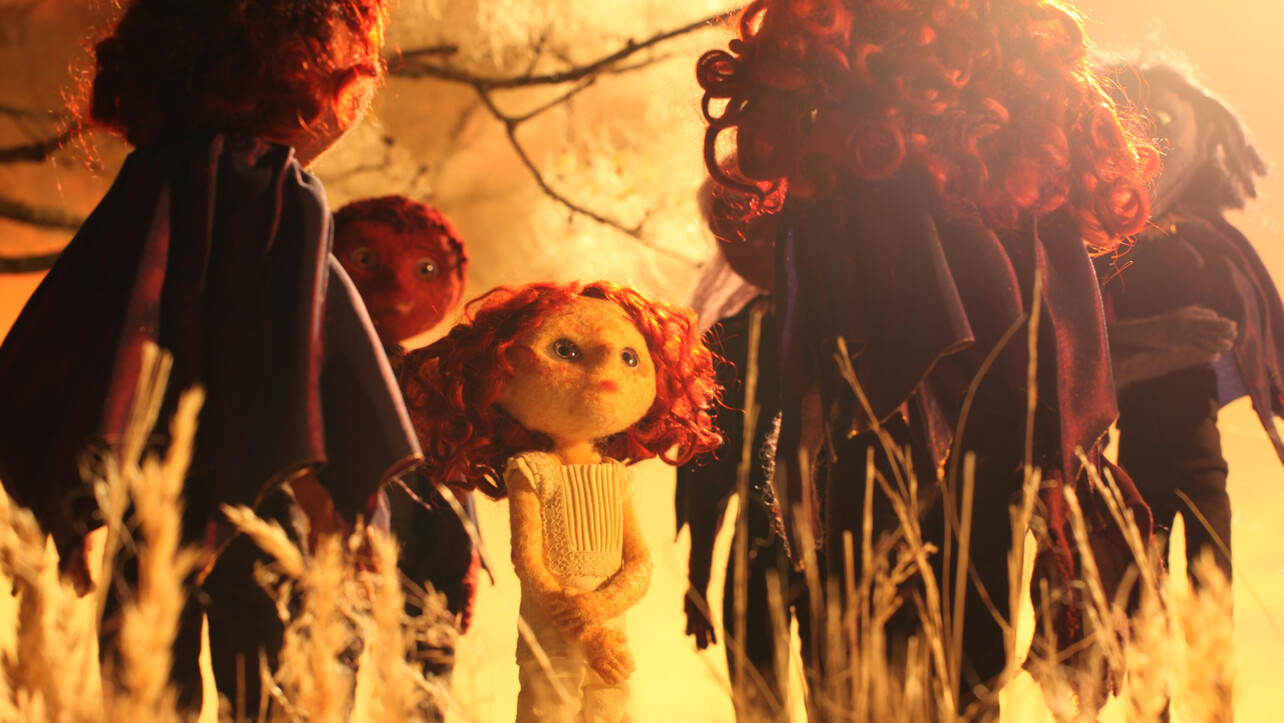
![À la mer poussière [To the Dusty Sea]](/fileadmin/_processed_/c/9/csm_to-the-dusty-sea---still2_5d747d6e72.jpg)
